Hadrian's Villa
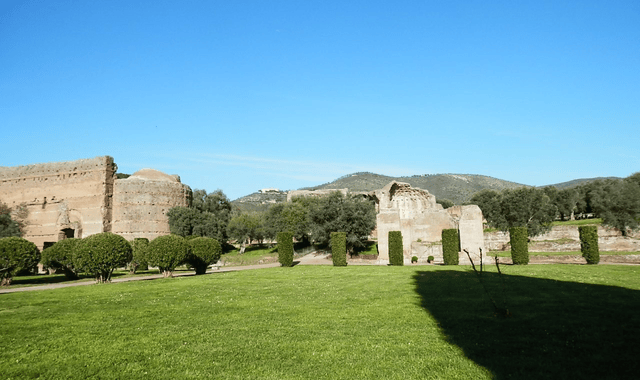
Hadrian's Villa

| UNESCO World Heritage Site | |
|---|---|
| Location | Tivoli, Italy |
| Criteria | Cultural: (i), (ii), (iii) |
| Reference | 907 [19] |
| Inscription | 1999 (23rd Session) |
| Area | 80 ha (200 acres) |
| Buffer zone | 500 ha (1,200 acres) |
| Coordinates | 41°56′46″N 12°46′21″E [20] |
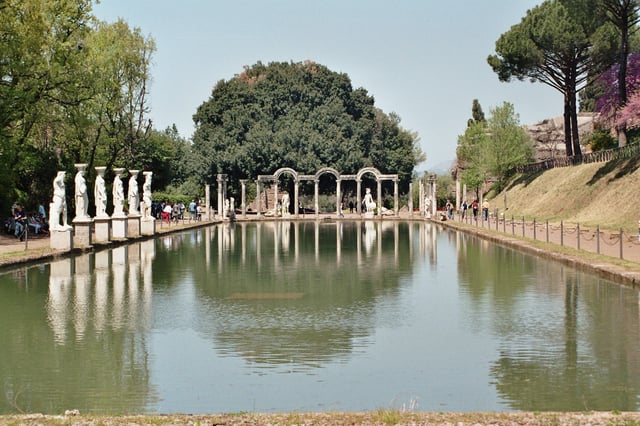
The villa's recreation of Canopus, a resort near Alexandria, as seen from the temple of Serapis
Hadrian's Villa (Villa Adriana in Italian) is a large Roman archaeological complex at Tivoli, Italy. A UNESCO World Heritage Site, it is the property of the Republic of Italy, and has been directed and run by the Polo Museale del Lazio since December 2014.
| UNESCO World Heritage Site | |
|---|---|
| Location | Tivoli, Italy |
| Criteria | Cultural: (i), (ii), (iii) |
| Reference | 907 [19] |
| Inscription | 1999 (23rd Session) |
| Area | 80 ha (200 acres) |
| Buffer zone | 500 ha (1,200 acres) |
| Coordinates | 41°56′46″N 12°46′21″E [20] |
History
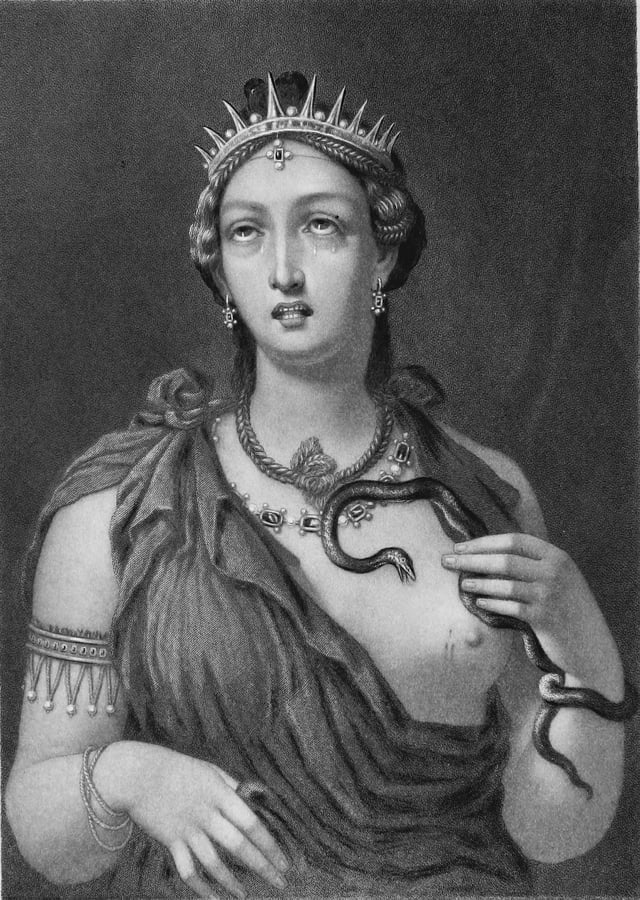
A steel engraving depicting Augustus' now lost painting of the death of Cleopatra VII in encaustic, which was discovered at Emperor Hadrian's Villa (near Tivoli, Italy) in 1818;[1] she is seen here wearing the golden radiant crown of the Ptolemaic rulers,[2] an Isis knot (corresponding to Plutarch's description of her wearing the robes of Isis),[3] and being bitten by an asp in an act of suicide.
The villa was constructed at Tibur (modern-day Tivoli) as a retreat from Rome for Roman Emperor Hadrian during the second and third decades of the 2nd century AD. Hadrian is said to have disliked the palace on the Palatine Hill in Rome, leading to the construction of the retreat. It was traditional that the Roman emperor had constructed a villa as a place to relax from everyday life. Previous emperors and Romans with wealth, such as Trajan, had also constructed villas. Many villas were also self-sustaining with small farms and did not need to import food.
The picturesque landscape around Tibur had made the area a popular choice for villas and rural retreats. It was reputedly popular with people from the Spanish peninsula who were residents in the city of Rome. This may have contributed to Hadrian's choice of the property – although born in Rome, his parents came from Spain and he may have been familiar with the area during his early life.
There may also have been a connection through his wife Vibia Sabina (83–136/137) who was the niece of the Emperor Trajan. Sabina's family held large landholdings and it is speculated the Tibur property may have been one of them. A villa from the Republican era formed the basis for Hadrian's establishment.
During the later years of his reign, Hadrian actually governed the empire from the villa. Hadrian started using the villa as his official residence around AD 128. A large court therefore lived there permanently and large numbers of visitors and bureaucrats would have to have been entertained and temporarily housed on site. The postal service kept it in contact with Rome 29 kilometres (18 mi) away, where the various government departments were located.
It isn't known if Hadrian's wife lived at the villa either on a temporary or permanent basis – his relations with her were apparently rather strained or distant, possibly due to his ambiguous sexuality. Hadrian's parents had died when he was young, and he and his sister were adopted by Trajan. It is possible that Hadrian's court at the villa was predominately male but it's likely that his childhood nurse Germana, to whom he had formed a deep attachment, was probably accommodated there (she actually outlived him).
After Hadrian, the villa was occasionally used by his various successors (busts of Antoninus Pius (138–161), Marcus Aurelius (161–180), Lucius Verus (161–169), Septimius Severus and Caracalla have been found on the premises). Zenobia, the deposed queen of Palmyra, possibly lived here in the 270s.
During the decline of the Roman Empire in the 4th century, the villa gradually fell into disuse and was partially ruined as valuable statues and marble were taken away. The facility was used as a warehouse by both sides during the destructive Gothic War (535–554) between the Ostrogoths and Byzantines. Remains of lime kilns have been found, where marble from the complex was burned to extract lime for building material.
In the 16th century, Cardinal Ippolito II d'Este had much of the remaining marble and statues in Hadrian's Villa removed to decorate his own Villa d'Este located nearby. Since that period excavations have sporadically turned up more fragments and sculptures, some of which have been kept in situ or housed on site in the display buildings.
Structure and architecture

The ruins of Hadrian's Villa in their present state
Hadrian's Villa is a vast area of land with many pools, baths, fountains and classical Greek and Roman architecture set in what would have been a mixture of landscaped gardens, wilderness areas and cultivated farmlands.
The buildings are constructed in travertine, brick, lime, pozzolana, and tufa. The complex contains over 30 buildings, covering at least a square kilometre (250 acres, an area larger than the city of Pompeii), of which much is still unexcavated. Villas were typically sited on hilltops, but with its fountains, pools and gardens, Hadrian’s villa required abundant sources water, which was supplied by aqueducts feeding Rome, including the Anio Vetus, Anio Nobus, Aqua Marcia, and Aqua Claudia. To avail themselves of those sources, the villa had to be located on land lower than the aqueduct.[4]
As the author of the Historia Augusta states,
[Hadrian’s] villa at Tibur was marvellously constructed, and he actually gave to parts of it the names of provinces and places of the greatest renown, calling them, for instance, Lyceum, Academia, Prytaneum, Canopus, Poecile and Tempe. And in order not to omit anything, he even made a Hades.[5]
The architecture goes beyond the mere naming of its structures naming after places and monuments seen by Hadrian on his extensive travels across the empire. Certain buildings clearly attempt to recreate specifc features of landscapes or architecture that had personal significance for the emperor. Thus, the area known as the Canopus, named after the Egyptian city where Antinoos drowned, features a long, stately reflecting pool, representing the Nile, which was lined with copies of famous works of sculpture including the caryatids of the Erechtheion, a statue depicting the Egyptian dwarf and fertility god, Bes and a crocodile. The Pecile is modeled after the Stoa Poikile in Athens, a city favored by Hadrian. The structures freely mix traditional Greek and innovative Roman elements. The island enclosure (known as the Maritime Theatre) uses the classical Ionic order, albeit in a novel way; the triclinium of the so-called Piazza d’Oro and the Serapeum were covered with Roman segmented concrete domes, probably designed by Hadrian himself.
Hadrian's Pecile located inside the Villa was a huge garden surrounded by a swimming pool and an arcade. The pool's dimensions measure 232 by 97 metres (761 by 318 ft). Originally, the pool was surrounded by four walls with colonnaded interior. These columns helped to support the roof. In the center of the quadriportico was a large rectangular pool. The four walls create a peaceful solitude for Hadrian and guests.
One structure in the villa is the so-called "Maritime Theatre". It consists of a round portico with a barrel vault supported by pillars. Inside the portico was a ring-shaped pool with a central island. The large circular enclosure 40 metres (130 ft) in diameter has an entrance to the north. Inside the outer wall and surrounding the moat are a ring of unfluted ionic columns. The Maritime Theater includes a lounge, a library, heated baths, three suites with heated floors, washbasin, an art gallery, and a large fountain.[6] During the ancient times, the island was connected to the portico by two wooden drawbridges. On the island sits a small Roman house complete with an atrium, a library, a triclinium, and small baths. The area was probably used by the emperor as a retreat from the busy life at the court.
The villa utilizes numerous architectural styles and innovations. The domes of the steam baths have circular holes on the apex to allow steam to escape. This is reminiscent of the Pantheon, also built by Hadrian. The area has a network of underground tunnels. The tunnels were mostly used to transport servants and goods from one area to another.
In 1998, the remains of what archaeologists claimed to be the monumental tomb of Antinous, or a temple to him, were discovered at the Villa.[7] This, however, has subsequently been challenged in a study noting the lack of any direct evidence for a tomb of Antinous, as well as a previously overlooked patristic source indicating burial in Egypt at Antinopolis, and treating the possibility of a sanctuary of Antinous at Hadrian's Villa as plausible but unproven.[8]
In September 2013, a network of tunnels was investigated, buried deep beneath the villa – these were probably service routes for staff so that the idyllic nature of the landscape might remain undisturbed. The site housed several thousand people including staff, visitors, servants and slaves. Although much major activity would have been engaged in during Hadrian's absence on tours of inspection of the provinces a great many people (and animals) must have been moving about the Tivoli site on a daily basis. The almost constant building activity on top of basic gardening and domestic activities probably led to subterranean routes being resorted to.
The villa itself has been described as an architectural masterpiece. A team of caving specialists has discovered that it is even more impressive than previously thought.[9]
Sculptures and artworks
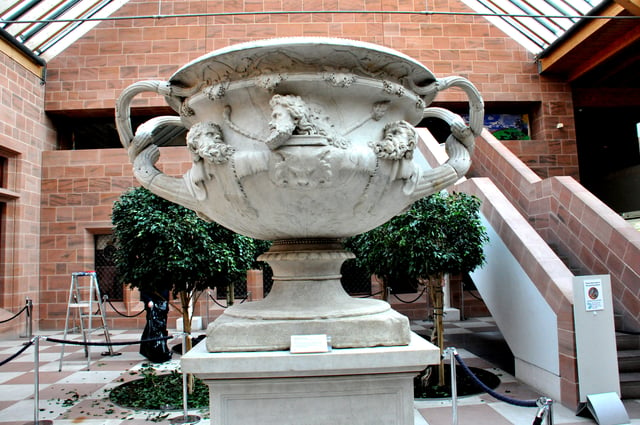
The Warwick Vase. From Hadrian's Villa at Tivoli. 2nd century CE. 18th century reconstruction. The Burrell Collection, Glasgow, UK
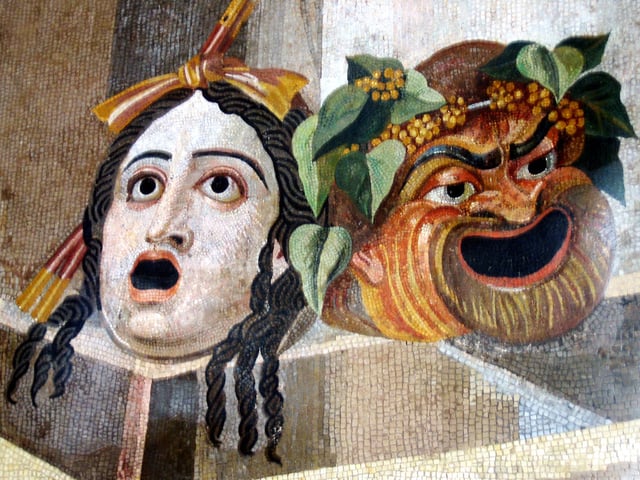
Theatrical masks of Tragedy and Comedy in refined mosaic, from the villa (Capitoline Museum, Rome)

"Battle of Centaurs and Wild Beasts" was made for the dining room of Hadrian's Villa and estimated to be made between 120-130 A.D. The mosaic now resides in the Staatliche Museen zu Berlin in Germany.
Many beautiful artifacts have been unearthed and restored at the Villa, such as marble statues of Antinous, Hadrian's deified lover, accidentally drowned in Egypt, and mosaics from the theatre and baths.
A lifelike mosaic depicted a group of doves around a bowl, with one drinking, seems to be a copy of a work by Sosus of Pergamon as described by Pliny the Elder. It has in turn been widely copied.[10]
Many copies of Greek statues (such as the Wounded Amazon) have been found, and even Egyptian-style interpretations of Roman gods and vice versa. Most of these have been taken to Rome for preservation and restoration, and can be seen at the Musei Capitolini or the Musei Vaticani. However, many were also excavated in the 18th century by antiquities dealers such as Piranesi and Gavin Hamilton to sell to Grand Tourists and antiquarians such as Charles Towneley, and so are in major antiquities collections elsewhere in Europe and North America.
Artworks found in the villa include:
Discobolus
Dove Basin mosaic, copy of a famous Hellenistic mosaic, Capitoline Museums
Diana of Versailles, Louvre
Crouching Venus
Capitoline Antinous
Young Centaur and Old Centaur (Capitoline versions)
Present-day significance
The United Nations Educational, Scientific and Cultural Organization (UNESCO) designated Hadrian's Villa as a World Heritage Site in 1999. The designation specified the boundaries of the site and created a buffer zone around it in which no new construction was permitted. In 2011, the communal government of Tivoli announced plans, later cancelled, to build a waste dump in the vicinity of the villa and approved the construction of public housing on 120,000 sq. meters within the buffer zone. At its 36th Annual Meeting, UNESCO formally addressed these encroachments on the site. While they commended the Italian government for its decision to abandon the construction of a waste dump in the Corcolle area, the committee requested the government “to inform the World Heritage Centre in due time about any major development project planned in the buffer zone of the property, including the housing development at Comprensorio di Ponte Lucano, for which a Heritage Impact Assessment should be included, in accordance with Paragraph 172 of the Operational Guidelines, before any irreversible commitment is made.” UNESCO also requested “the State Party to submit . . . an updated report on the state of conservation of the property,” by February 2014, reflecting concerns over the deterioration of the exposed ruins.[11]
In 2016, as part of the reorganization of the Ministero per i Beni e le Attività Culturali, Hadrian’s Villa, the neighboring Villa d’Este and the Temple of Hercules in Tivoli were placed under the supervision of the newly-created Istituto Autonomo di Villa Adriana.
The Accademia Adrianea di Architettura ed Archeologia1 issued a call for papers for a conference entitled Designing the UNESCO Buffer Aobe
The Academy of the villa was placed on the 100 Most Endangered Sites 2006 list of the World Monuments Watch because of the rapid deterioration of the ruins.
In 2019, UNESCO designated Hadrian’s Villa as a site with special immunity from wartime activity. This added level of security prohibits U.N. members from attacking the site or using it for military purposes in the event of a war.
[[File:Lazio Tivoli2 tango7174.jpg|thumb|center|upright=2|The Maritime Theatre]p
See also
List of Roman domes
History of Roman and Byzantine domes
Villa Romana del Casale ruins of a Roman senators villa

